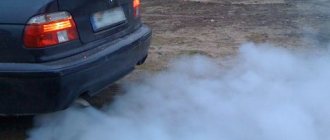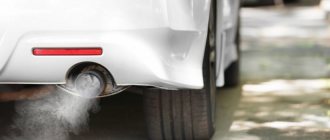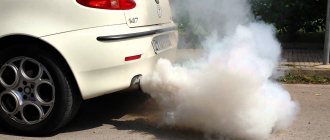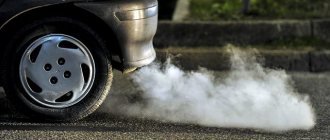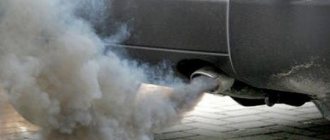If you pay attention to the rear of the car while warming up a cold engine, you will notice an interesting phenomenon - water splashes from the exhaust pipe along with the exhaust gases. In the warm season, literally a few drops form, and in winter there is often a wet path or puddle behind the car. This worries inexperienced car enthusiasts who perceive splashes from the exhaust tract as a symptom of a malfunction. To make sure that suspicions are groundless, it is necessary to understand the nature of this phenomenon.
How does moisture get inside the muffler?
In the vast majority of cases, splashes of water escaping from the exhaust pipe do not indicate any failure and do not pose a danger to the “health” of the car. Splashes can be observed on almost all cars, regardless of class and model. The reasons for the formation of moisture lie in ordinary physical phenomena and chemical reactions occurring inside the engine and exhaust tract:
- Condensation resulting from contact of hot surfaces with cold outside air.
- The release of water as a product of the chemical reaction of hydrocarbon fuel combustion occurring in the cylinders of the power unit.
- During residual afterburning of combustible gases, water vapor also forms inside the catalytic converter.
Each reason requires detailed explanation. In the first case, moisture forms after stopping the running engine, when the exhaust tract has become thoroughly heated. Water vapor suspended in the air condenses upon contact with hot surfaces. The more humid the outside air and the greater the temperature difference, the more intense condensation occurs. This is why much more liquid flows out of the pipe in winter than in summer.
Reference. The greatest amount of condensation occurs during periods of rain and fog, when the air is oversaturated with moisture.
Water vapor is also a product of combustion of gasoline, liquefied gas and diesel fuel. When oxidized, a hydrocarbon compound disintegrates with the release of heat. As a result of a chemical reaction, 2 substances are formed - carbon dioxide and water, which evaporate at the time of combustion. The steam is released through the valves into the exhaust pipe, where it partially condenses.
Since the combustion conditions of gasoline are not very ideal, unburnt carbon monoxide (CO) is formed in the chambers, which is sent along with the exhaust to the catalyst. There the final oxidation and combustion of gasoline vapors occurs, again releasing water.
Consequences of condensation release
Drops that appear inside the exhaust pipe after stopping the engine flow down and accumulate in the cylindrical resonator housing. The next time you start a cold engine, they are squeezed out by exhaust gases, as a result of which water drips from the muffler until the tract warms up. The remaining liquid evaporates from the hot pipe and is thrown out along with the smoke, the outflow stops.
What are the consequences of water accumulation inside the exhaust system:
- If the car is stored in an open parking lot in winter, the moisture will be captured by frost after cooling. Ice will appear in the pipe, partially blocking the flow area.
- Freezing of water in the muffler and resonator tanks reduces the service life of these elements. Because ice formation is accompanied by expansion, metal walls and welds are subject to tensile stress.
- The exhaust system, made of ferrous metal with an anti-corrosion coating, runs the risk of rusting over time. Condensate contains sulfur and other aggressive substances that cause corrosion. Stainless steel pipes are not susceptible to chemical attack.
Note. An ice plug that completely blocks the passage of flue gases is a rather rare occurrence. Normal moisture release processes described in the previous section do not lead to similar consequences. The maximum that can happen is a build-up of icicles at the end of the pipe.
Since condensation always appears in the exhaust pipe in all cars, the difference in exhaust system wear is almost unnoticeable. Gas ducts and tanks made of ferrous metal last from 20 to 50 thousand kilometers, and any fistulas that arise can be repaired using conventional welding and thus extend the life of the elements. Stainless steel lasts twice as long – up to 100 thousand km.
Features of modification of the muffler for condensate drainage
Not all mufflers rust quickly; there are even inexpensive car models on which the rear canister can last up to 10 years without modification or any repairs (for example, Renault Logan). The metal of the exhaust system on Chinese cars most often succumbs to rust, this applies to Chery, Lifan, Great Wall cars. Also, many non-original spare parts do not last long, so they all need improvement, and draining the water would not hurt. Why the holes are made at the very back of the can, at the bottom and of a certain diameter, is easy to explain:
- if you drill closer to the engine, exhaust gases will partially enter the cabin, which will certainly cause a lot of inconvenience and trouble for passengers and the driver;
- with larger diameter holes, an additional sound of a growling muffler will appear (although some people, on the contrary, like the sound);
- at a higher level of drilling, the water will not completely leave the can, and the rusting process will continue.
When should you be wary?
In some cases, the release of water indicates certain problems with the motor:
- the amount of condensate is too high;
- the flow does not end after the engine and exhaust system warm up;
- the flying drops have a distinct black color or leave oily stains on the asphalt.
If strong condensation comes from the exhaust, which does not stop when the engine warms up and is accompanied by white smoke, there is a breakdown of the cylinder head gasket (cylinder head). This means that the crack has connected the channels of the block's water jacket with the combustion chamber. Antifreeze penetrates the cylinders, evaporates from the high temperature and is thrown into the exhaust system. As a result, you observe the release of white steam and coolant, which has managed to partially condense.
Advice. If you discover a violation of the integrity of the cylinder head gasket, immediately begin repairing the power unit. Driving with this malfunction is unacceptable.
Both the color of the exhaust gases and the color of the condensate may indicate a specific problem. Black water from the muffler indicates a large amount of soot contained in the smoke and deposited on the inner walls of the pipes. There are two reasons for its formation:
- poor fuel combustion conditions (wear of the cylinder-piston group, problems with the fuel supply, ignition system, and so on);
- refueling with low-quality gasoline or diesel fuel.
There are cases when soot from unburned or low-quality fuel completely clogged the pipeline system, making it impossible to start the engine.
An oily puddle under the exhaust pipe may indicate wear on the cylinder-piston group or valve seals. Engine lubricant, penetrating into the cylinders, burns and is partially released into the flue and mixed with condensate. The problem is accompanied by bluish smoke, carbon deposits on the electrodes of the spark plugs and increased oil consumption in the engine.
Is it possible to reduce the amount of liquid in the exhaust?
The intensity of condensation inside the exhaust system is practically independent of the make and model of the car. It should be understood that a small amount of water in the pipe is normal. The exception is a situation when liquid flows like a river due to a cylinder head gasket failure.
Since you can't control the chemical reaction of gasoline burning to release water vapor, try to combat condensation. What is needed for this:
- reduce the temperature difference between the heated surface of the pipe and the surrounding air;
- reduce the humidity of air in contact with hot flues;
- create conditions for natural evaporation of condensate.
There is only one way to meet these requirements - store the car in a warm, tightly closed garage equipped with exhaust ventilation. Less moisture will fall out of the heated and drier air, and thanks to the positive temperature, the condensate will evaporate during parking and be removed through the hood. Please note that it will not be possible to completely get rid of water droplets from the muffler.
Condensation in a car exhaust system occurs when cold and hot air mix. Dripping water from the muffler always frightens a novice car owner. Is it so scary and what negative consequences could there be?
Where does the water in the exhaust come from?
Water vapor tends to turn into condensate. In a car, condensation collects in many places - in the exhaust and cooling systems, in the fuel and coolant lines. Moisture also accumulates in the interior and hard-to-reach niches of the body.
After stopping the engine, condensation begins to form in the exhaust system. This happens even on new cars that are fully working. This is explained by the fact that the outside of the system cools much faster than the inside. Therefore, drops of water splash from the muffler. They can quickly harden, coating the inside of the muffler with an icy crust. There will not be much damage, although many drivers are confident of the opposite.
The natural formation of moisture in the exhaust system is inevitable. It is the most intense:
- after active use of the car;
- on cars with automatic start;
- after sharply pressing the accelerator pedal.
If condensation appears at temperatures below 0 and there is little of it, it’s okay.
Water from the muffler: reasons
There are 2 reasons why water drips from the muffler. Condensation can appear from the outside - when snow and rain penetrate into car systems. In the second case, moisture forms directly in the exhaust, since any engine runs on a fuel-air mixture.
A hot engine produces steam, the amount of which increases due to sudden temperature changes.
Condensation can also accumulate in other vehicle systems:
- In the engine itself. White deposits at the neck are traces of condensation.
- Near the valves (due to gasket damage).
- In the lubrication system (due to refrigerant).
- In the fuel tank (due to the use of low-grade fuel).
Try to keep the tank filled to the brim and park the machine indoors. Then the risk of moisture in the tank will be minimal.
Moisture inside the car is a big problem, because it may not reach the muffler, remaining invisible.
The liquid will significantly accelerate the wear of the elements. Therefore, it is worth regularly checking the engine compartment and undergoing maintenance in a timely manner.
The presence of condensation in the fuel tank can be determined by difficulty starting the engine or by engine interruptions. Moisture gets inside the tank along with low-quality fuel.
When refueling, look at the price of gasoline or diesel fuel. If it is significantly lower than the market price, be wary and do not rush to rejoice. The octane number is easily increased synthetically, using additives. Therefore, it is better to go to proven, branded gas stations.
Experienced motorists try to always keep the fuel tank full. This is not a whim, but an opportunity to avoid the appearance of condensation even with low-grade fuel. There is simply no room left for moisture inside the tank. Conversely, regular partial refueling helps retain moisture in the gas tank and other car systems.
There is no less trouble with condensation in the engine. It comes here from the fuel tank. A sign of a problem is excessive heating of the motor. You need to inspect the car for leaky gaskets or valves. If there is moisture on the internal combustion engine itself, this can be determined by grease stains on the engine body. The oil mixes with hot air, evaporates, and settles as condensate.
You can get rid of moisture in the tank and engine by using chemistry - special enzymes dissolve in water. Compounds are formed that easily burn out during engine operation without causing damage to the engine installation.
Water is more likely to form in cars with modern exhaust gas treatment systems. Condensation may leak from the muffler while driving. It occurs in the catalyst, which oxidizes platinum, palladium and other harmful compounds coming from the engine. As a result of the reaction, carbon dioxide and water vapor are formed, which remains on the walls of the pipe.
Freezing of the muffler due to the accumulation of condensate in it
If the car is left in an open parking lot in the cold in winter, a lot of moisture can accumulate in the exhaust system, and water often freezes in a low elbow and in a narrow place. As a result, ice blocks the passage of exhaust gases, problems arise with starting the internal combustion engine - the car will start, then immediately stall. In such cases, it is necessary to warm up or tap (clean) the exhaust tract, but in general there are several solutions:
- try to clean the pipe if ice has formed at the back (not in the elbow between the cans);
- tow the car to a warm garage or service station;
- warm up the “outlet” using a hair dryer;
- use the services of visiting specialists;
- take the car to a car wash to warm up the muffler using hot water.
Heating with an open flame (gas burner, blowtorch, etc.) is not recommended; all other methods can be considered. And in order to avoid the repetition of such cases, holes must still be made in the muffler, you should also gas the car to blow out condensation before parking, do this also when starting the car, park the car not on a descent, but on an ascent.
Moisture in the internal components of a car is a sign of the proper functioning of its main components. At the same time, there is no need to grab your head and rush to the nearest service station. After all, there can be no talk of any defect here. Although novice car enthusiasts are sometimes shocked when this moisture accumulates in a decent puddle. A reasonable question: why is there a lot of water in the muffler? This already depends on the ambient temperature, operating mode and fuel quality.
What is the danger of water in the muffler?
Natural transparent condensation is not a problem if there is little of it. It’s just water - its accumulation, on the contrary, indicates the serviceability of all systems. Things get worse if the moisture has an unusual color and thick black smoke appears.
Danger No. 1 - condensation can turn into ice. This threatens to rupture the muffler or resonator. In addition, when water freezes, important channels connecting the motor to other systems become clogged. Therefore, it is very difficult, almost impossible to start the car.
Danger #2 is corrosion. The internal cavities of the exhaust system quickly rust. For example, on the first VAZ cars, the resonators and pants rotted in almost 3 years, although they were made of durable steel. With a stainless muffler of foreign cars, things are somewhat better, but condensate can react with sulfur dioxide (present in the exhaust of any internal combustion engine), form acid and corrode the metal in 1-2 years.
Making holes in the muffler (resonator)
When the engine is in good working order, the formation of condensation does not cause serious problems, except for one point: the moisture accumulated in the muffler cans, which remains inside for a long time, contributes to the formation of rust, because of this, the elements of the exhaust system may fail earlier. Of course, a lot depends on the quality of the metal, but on budget cars the “exhaust” parts rust quite quickly.
It’s easy to make holes in the “silencing” can; it’s convenient to do the work in a pit or on a lift in a garage where there is electricity. To do this you will need an electric drill and a drill of approximately 1.5-2 mm, perform the operation as follows:
- we go down under the car (raise the car on a lift), find the rear muffler can, use a drill and drill to make a hole (preferably at the lowest point);
- It is necessary to operate the drill very carefully, since when drilling metal, water almost always begins to flow out, so the power tool must be put aside in time;
- You can also make a second hole from the bottom on the other side of the can; by the way, on some cars mufflers with two similar technological holes can be installed.
Some car owners believe that after drilling, the metal will begin to rust more intensively in this place and the service life of the exhaust system will be reduced. But this issue is controversial, since it is not known what will cause the muffler to rot faster: from the water inside or from the hole made. Although the average service life of exhaust parts is approximately three years, exhaust pipes on more expensive cars usually last longer.
How to get rid of water in the muffler
Moisture should not actively accumulate inside the muffler. You can avoid its formation by following these recommendations:
- Increase the engine warm-up time if the engine has automatic warm-up. You can use a separate liquid heater if the muffler does not have time to heat up.
- Do not leave your car outdoors in winter.
- Use quality fuel. The low grade is all water.
- Place the car at an angle with the front end down after starting the engine. This method will reduce the intensity of corrosion on metal walls.
- Insulate the muffler (especially important for cold areas). Any non-flammable heat insulator can be used.
It’s worth making long trips at least once every 30 days (preferably in winter or autumn). This will make it possible to warm up the car and its exhaust system well. An hour-long drive along the highway at high speeds is the best way to remove excess moisture from the silencer. Short trips around the city do not give such an effect. This, on the contrary, is a destructive factor - the condensate will only have time to thaw and turn into water.
Is it possible to drill the muffler?
You need to drill the resonator, not the muffler itself. A thin 3mm metal drill is placed on the drill. Up to 250 ml of water can leak from the exhaust cans. The method is imperfect, but quite safe. Some drivers even use it on new cars.
The manufacturer does not recommend making holes in the resonator. The metal of the muffler quickly becomes unusable after this, because even a small hole is a potential source of corrosion. Due to high temperatures and dirt, the process of rust spreading becomes more intense. In addition, a leaky muffler makes a lot of noise and exhaust gases enter the cabin.
The lifespan of exhaust elements is 4-5 years. With regular use of the car - even less. When purchasing a new silencer, give preference to models with anticorrosive properties.
Every second driver in the Russian Federation is forced to solve a problem with condensation. The humid Russian climate is the reason for this. Be careful, monitor the amount of moisture. A small amount of water is not a problem. If there is too much of it, it is better to contact a car service, perform diagnostics and accurately find the source of the problem.
Almost every motorist faces the problem of condensation in the muffler and, as a result, leakage of water droplets from the exhaust pipe. This phenomenon, which is relevant both in winter and summer, often leads car owners to suspect that there are problems with the systems. At the same time, the formation of steam and leakage of liquid, being a normal physical process, does not always indicate a malfunction. Condensation can collect on new cars in the same way as on those with decent mileage, and in most cases does not cause any damage, so most often there is nothing to worry about. But if the leaking liquid has an unusual color or clouds of white smoke come out of the pipe, then this is a reason to think about it and go for diagnostics.
Is condensation in a car dangerous?
Moisture settled in the muffler is a sign of proper operation of the internal systems of the car. Although such a phenomenon does not pose a radical danger, it would be thoughtless to turn a blind eye to it. The main reason for this is corrosion. Experts at domestic service stations claim that exhaust gases are no less aggressive than condensate. But water in a car muffler is still a potential threat, just like any metal liquid. The same applies to the gas tank, engine, and interior - in these places moisture sometimes accumulates in the same volumes as in the muffler.
In addition to the fact that water will splash spectacularly from the exhaust pipe, the car owner will also face a banal inconvenience. During a trip, few people will ignore the gurgling and “spitting” sounds made by the muffler, and in the cold season an additional nuisance appears - an ice jam. Frozen condensation can simply block the exhaust outlet, causing the car to not move.
- Pediculosis - what is it, effective treatments
- How to change your VKontakte name
- How to clean a washing machine with citric acid
If water flows from the exhaust pipe on a warm engine
Moisture can get from the fuel tank into other vehicle systems. If the neck of the oil filler cap is stained with a white coating, then condensation is present in the engine itself. If the gasket is damaged, similar marks remain near the valves. Even antifreeze mixed with oil can have the same appearance. In any case, moisture in the engine is a risk of increased heating.
The source of the problem lies in leaky car parts, but if these damages are not detected even after a thorough inspection, then it is too early to worry. Condensation may occur due to the mixing of water and oil on the engine. Ordinary moisture removers will help get rid of it. When interacting with water, these substances enter into a chemical reaction. This creates compounds that burn during engine operation without harm to the insides of the car.
If black liquid drips
The concern begins from the moment when the condensation flowing out of the exhaust pipe shimmers with an unusual hue. It can be black, blue, and sometimes yellow-green. But the color of moisture from the muffler should not puzzle the car owner. On the contrary, this shade will give an understanding of the nature of the problem:
- Some parts of the car are very worn. There may be an oil leak or the coolant is turning the moisture from the muffler an unusual color.
- Cheap, low-quality fuel with a high content of additives. The latter, as a rule, do not burn out, but come out of the muffler along with condensate.
- A high concentration of soot in gasoline turns the moisture yellow-green.
- Soot has settled inside the muffler, causing black water to drip from the exhaust pipe.
The cause of colored condensation can only be determined through diagnostics. Preliminary conclusions can be drawn from an independent inspection of the car:
- Check the composition of the condensate. After warming up the engine well, you need to cover the exhaust pipe with thick paper. After which this sheet is set aside to dry in a warm place. If there are greasy stains on it, this indicates an oil leak.
- Inspect the area under the hood. All attention must be concentrated on searching for oil films. With such a breakdown, anyone standing next to the car will smell the characteristic oily smell of a leak.
- Inspect the spark plugs. One or even several of them may look perfectly clean in appearance. This is a sure sign that she/they have been exposed to coolant.
- Check the oil and antifreeze scale. Overconsumption of these components leads to leaks.
- Check the condition of the engine. Its overheating may be due to a leak in the internal transport systems.
- Find a new fuel supplier. The quality of gasoline from another gas station may differ significantly from the previous one.
- Do not avoid visits to the service station. Specialists from a decent car service center will see something that most drivers simply won’t pay attention to. Self-diagnosis of parts does not guarantee any results; machine maintenance should be entrusted to experienced professionals.
If there is white smoke coming from the muffler and water
This is a sign of moisture accumulated inside the gas tank. From there, the liquid enters the exhaust pipe, onto the spark plugs and fuel pump. In the same way, it can end up in a car engine. The cause of the problem is low-grade fuel, which is sold at old, small or cheap gas stations. To avoid this, you need to inquire about the price of gasoline. If its cost at a particular gas station is lower than the city average, then not everything is so rosy.
Such a step is taken only when fuel is supplied with an octane number artificially increased by adding additives. Proven gas stations from well-known companies are definitely more reliable. But even low-quality gasoline is not a major hindrance if you fill the tank with it full. So there will be physically no place left for moisture where it could form. Otherwise, the risk of condensation inside the cylinders increases significantly.
How does moisture get inside the muffler?
We regularly encounter the phenomenon of condensation in everyday life, and it is always undesirable, no matter where it occurs, and sometimes it can act destructively on structures, being also one of the provoking factors for corrosion. Every schoolchild knows from physics lessons where condensation comes from, and if water begins to flow out of the muffler, which can most often be detected when starting a cold engine, then this is not a sign of design defects. Let's take a closer look at why water drips from the muffler, which promotes condensation. The reasons for the formation of condensation in the exhaust system of a car lie in physical processes, as well as chemical reactions occurring in the internal combustion engine chamber:
Consequences of condensation release
Due to frequent use of the car, the liquid simply does not have time to evaporate; as the unit warms up, steam begins to be released, and then water drips from the exhaust pipe, but with the engine in full working order at the desired temperature, the problem should disappear. Condensation that naturally accumulates in the muffler is not as dangerous as it might seem at first glance, although it does not bring any benefit. The consequences of its presence in the exhaust system are as follows:
- When a car is parked in open parking lots in winter at sub-zero temperatures, the liquid inevitably freezes. A crust of ice appears in the pipe, which can partially or even completely block the passage, preventing the exhaust gases from escaping. The exhaust gases, returning, deplete the fuel mixture, as a result of which the car may simply not go anywhere. An ice jam is a rare occurrence; usually, leaving a car in the cold leads to the formation of icicles on the pipe;
- Freezing of water reduces the service life of parts of the exhaust system; as a result of expansion caused by the appearance of ice, a pipe or resonator may even rupture;
- Moisture plays an important role in the onset of corrosion, but rust is caused not so much by the liquid accumulating in the muffler, but by other reagents contained in the exhaust and having an aggressive effect.
Since the exhaust system can be made of different materials (ferrous metal, aluminum, stainless steel), it will serve differently. Stainless steel is the most durable; subject to natural exposure to moisture and exhaust gases, the pipe will last up to 100,000 km. vehicle mileage.
When to be wary
There is no need to immediately ring the alarm bell and go to the service center when you see water flowing from the exhaust pipe. Motorists' fears are largely unfounded. You only need to worry in cases that predict problems with the engine:
- Excessive leakage of water;
- After warming up the engine and exhaust system, condensation does not stop;
- Drops of water are black in color and leave oily stains;
- Along with the liquid, thick white smoke comes out of the pipe.
The presence of strong condensation, accompanied by white puffs of smoke, indicates that the cylinder block gasket has worn out, then it must be replaced immediately. A breakdown causes antifreeze to enter the cylinders, which evaporates and is released into the exhaust system. Meanwhile, the coolant level drops noticeably. The black color of the condensate indicates a large amount of soot settling on the walls of the muffler for the following reasons:
- Using low-quality fuel (soot can completely clog the system and prevent the unit from starting). Sometimes, when using low-quality fuel, the condensate has a yellow-green color, indicating a high sulfur content;
- Violation of the combustion process of the air-fuel mixture. This can be caused by wear of the cylinder-piston group, problems with the ignition system, lack of proper fuel supply and other malfunctions of the participating elements.
Oily discharge from the muffler may indicate wear of the cylinder-piston group or valve seals, since the engine oil entering the cylinders burns along with the fuel and is partially directed to the exhaust gas exhaust system. The smoke from the chimney acquires a bluish tint, and the malfunction is also characterized by signs of carbon deposits on the spark plugs and increased consumption of engine lubricant.
Causes of black smoke depending on engine type
Car engines run on gasoline (carburetor and injection designs) and diesel. The units differ in the way fuel is injected into the combustion chambers, therefore the causes of black smoke from the muffler are different.
Carburetor
The good old (and half-forgotten) carburetor is found on mopeds, motorcycles, walk-behind tractors, scooters, and Gazelles of early years of production. An important condition for the operation of a simple and reliable design with single injection is the correct stoichiometric composition. This is the ratio of fuel to air, normally 1 to 15.
But the balance can be upset due to a number of circumstances:
- debris got into the air jets;
- excess fuel appears in the float chamber;
- mechanical problems have arisen with the throttle valves;
- emulsion tubes fell out;
- the operation of the elements dispensing gasoline was disrupted.
A lean as well as a rich mixture produces poisonous black smoke from the exhaust pipe of a carburetor gasoline engine. In this case, the unit must be disassembled, washed, and repaired. To restore functionality, a simple set of plumbing tools is enough.
Black smoke at idle
Injector
In cars with a targeted supply of fuel to the cylinders (for example, Mercedes, Ford), the problem is fully present. There are many reasons for black smoke from the exhaust pipe of a fuel-injected gasoline engine. But diagnosis is complicated by the complexity of the mechanism.
Problems with injectors
Electromechanical devices are located in front of the intake valve. One of the elements of the fuel injector is the atomizer. When it wears out, fuel overflow occurs, resulting in thick black smoke pouring out of the muffler.
Faulty sensors
The injector is replete with sensors. Sensors control:
- air flow;
- engine temperature;
- crankshaft and throttle position;
- detonation and phases.
The operation of the controllers goes wrong for various reasons, then the elements transmit distorted information to the ECU. The block generates incorrect commands to the actuators: the motor begins to smoke.
Fuel pump
The gasoline pump (PG) in an injection power system is perhaps the most important component. However, the pump can create excessive pressure, although its regulator is considered quite reliable. The result of the violation will be soot emissions from the muffler.
Diesel
When a heavily loaded KamAZ smokes as it climbs the mountain, the picture surprises no one. But passenger cars, such as Volkswagen Passat, Hyundai Sonata, Kia Rio, and Niva Chevrolet, run on diesel fuel and also emit toxic combustion products. Emissions can tell a lot about the condition of a car's components.
Particulate filters
The cellular structure of diesel particulate filters traps solid particles of combustion products ranging in size from 10 nm to 1 micron. Filter elements in pairs are located behind the catalysts. Or they are built directly into the metal body of the exhaust gas neutralization device.
Particulate filters
The particulate filters contain differential pressure and temperature sensors that monitor the degree of contamination of the elements and transmit information to the engine ECU.
Clean filter elements allow only 0.1% of harmful compounds into the atmosphere. Particulate filters cannot be repaired, so if they become critically dirty, the consumables must be replaced.
High pressure pump
In the high pressure fuel pump (HPF), the speed sensor may fail or there will be a diesel fuel leak. The pressure in the pump should be 300 kg/cm2, which can be verified using the RB-4802 tester or another similar device. Water often gets into the plunger pairs of the device, then when the motor starts, the pump will jam.
A fuel injection pump malfunction is accompanied not only by a black tail at the rear of the car, but also by increased fuel consumption, engine overheating, and extraneous noise from the power plant.
Ignition timing
The air-fuel mixture in diesel engines is ignited by contact with air heated as a result of compression in the working chambers. Diesel fuel is supplied to the cylinders at a precisely calculated moment at the end of the compression stroke.
If the ignition angle is set incorrectly, fuel injection will not occur in a timely manner. A dark curtain that envelops road users will warn about inefficient combustion of diesel fuel.
Turbocharged engines
Aggregate air charging, which increases engine power with constant cylinder volumes, contributes to the occurrence of coal-colored smoke. The process is also accompanied by a characteristic whistle.
Look for and remove blockages in the air ducts, examine the intake tract and exhaust manifold: a leak may be found here.
Exhaust tract
Roar, metallic knocking, rattling from under the bottom of the car scream about breakdowns in the exhaust tract of the diesel internal combustion engine.
Collector defects are divided into three groups:
- Mechanical, obtained when hitting obstacles or meeting curbs. Cracks appear on deformed pipes, and the fracture sites burn out.
- Corrosive, appearing from moisture, reagents, condensate. The metal parts of the exhaust tract rust and deteriorate.
- Operational, caused by natural aging processes.
When the collector has served its purpose, it will smoke when starting, accelerating and decelerating the car: solid carbon particles will not encounter obstacles in their movement onto the street.
How to deal with water in the muffler and is it worth doing at all?
Condensation is a common phenomenon that occurs in the systems of all vehicles, regardless of manufacturer or model. There is no point in fighting natural dew; water will accumulate in the muffler, no matter how hard you try. The main condition for the formation of droplets on surfaces is a decrease in air temperature to the dew point or even lower. The dew point is reached when the air humidity and the pressure of the contained water vapor are increased to their limit, that is, they are equal to the maximum value. So, to prevent this phenomenon it is necessary:
- Reduce the temperature difference between the air and the structure;
- Reduce air humidity;
- Provide conditions for rapid evaporation of water.
Among the methods describing how to get rid of a large accumulation of condensate in the muffler, motorists often use a barbaric option, which involves drilling holes in the resonator, which will remove excess water, but this will not solve the problem if problems arise with engine elements, and natural condensation can be reduced by more gentle methods methods:
- The car must be operated not only over short distances, but also over long distances;
- It is best to park the car in a warm garage with good exhaust ventilation;
- The automatic heating option often does not have time to heat the muffler to the required temperature, as a result of which moisture still appears. It makes sense to increase the warm-up time to solve the problem;
- Low-grade fuel can lead to a number of different malfunctions, and water leaking from the muffler is only a small part of the troubles associated with this, so it’s worth thinking about switching to high-quality fuel.
It will not be possible to completely protect against the appearance of condensation; all the considered actions are aimed only at reducing its amount in the system and promoting the rapid evaporation of water droplets. At the same time, in most cases there is no need to worry about condensation; as practice shows, only an abnormal color of liquid or smoke can indicate a malfunction.
The best prices and conditions for the purchase of new cars
How to prevent liquid from appearing in the exhaust pipe
Whether it’s a luxury car or an old car, this will not protect you from the laws of physics; condensation forms in all of them. The same applies to the quality of gasoline - there will be moisture in all brands, albeit in different volumes. But if water gets into the muffler, then effective recommendations should be followed. Tested by time and practice, they will help get rid of condensation:
- Store the car inside the garage when cold weather sets in. Many car owners prefer to leave their vehicles in the cold, not wanting to waste time walking from home to garage - in winter this is a gross disrespect for their car. If you park it in a warm room at night (for example, in a garage), then in the morning it will take less time to warm up.
- Auto warm-up This feature is available in most modern cars. It is important to set it up correctly so that the muffler warms up along with the car. Otherwise, there is no guarantee that even when this system is activated, the exhaust pipe will not be clogged with icy condensate. This applies to both cars with injectors and carburetors - however, the latter warm up more slowly.
- Pay attention to the parking spot. If the car is parked on a slope towards its muffler, then water flows out of it faster.
- Arrange at least weekly long trips. This is an effective prevention against the formation of an ice plug from frozen moisture.
- Insulate the exhaust pipe of a car if there is neither a garage nor a heating function. Non-flammable heat insulators or liquid heating are suitable for this.
- Change gas station. Poor quality fuel also contributes to the formation of condensation inside the muffler.
- Drill a tiny hole in the resonator. An old and controversial method that ensures the free flow of water. The disadvantage of this method is that this same hole will serve as a catalyst for the development of corrosion.
